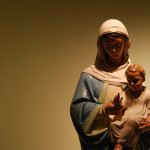We run our website the way we wished the whole internet worked: we provide high quality original content with no ads. We are funded solely by your direct support. Please consider supporting this project.

Conflicting Pictures of God
In my ongoing reflections on the ReKnew Manifesto, I’ve spent the last two posts (here and here) arguing that nothing is more important in our life than our mental images of God. If so, then the all-important question is: what authority do we trust to tell us what God is like? To most evangelicals, the answer is obvious: “the Bible.” If the Bible is the one and only inspired Word of God, what other answer could one possibly give?
I fully agree that the Bible is the inspired Word of God, but I think we have to be careful saying we should base our mental picture of God on this. For this would suggest that all of its various portraits of God have equal authority to tell us what God is like. In this case, for example, the portrait of God telling his people to “destroy [the Canaanites] totally” and to “show them no mercy” (Deut 7:2) as well as the multitude of pictures of God engaging in horrific violence would have the same authority to reveal God to us as the portrait of God revealed in Christ. Every violent portrayal of God in the Old Testament would be on a par of the portrait of God giving his life for his enemies and praying for their forgiveness with his last breath that we find in the crucified Christ. In other words, Christ would comprise only part of our mental image of God, but not the whole image.
In this light, it’s not surprising that so many Christians have conflicted images of God. Luther and Calvin, for example, celebrated the beautiful love and mercy of the God revealed in Christ, but they also both spoke of a dark side to God that is hidden behind the cross. Though he’s revealed in Christ to be full of love, both of these theologians envisioned another side of God which predestines all the evil that comes to pass and even decrees that the majority of humans spend eternity in hell. In his Institutes of the Christian Religion, Calvin himself called the decree of damnation “a horrible decree.”
It’s been my experience that, by virtue of giving all portraits of God equal authority to define our image of God, most Christians have, to one degree or another, a composite image of God in which Christ represents the “loving side” of God while the Father represents a side that is capable of engaging in behaviors that seem the opposite of loving – like predestining Auschwitz and the damnation of untold numbers of people. And with such amalgamated mental pictures of God, it’s not surprising that so many find it hard to passionately love God or get all their LIFE from God.
I agree that the Bible is the inspired Word of God, but as we’ll begin to see in my next post, the Bible itself teaches us that we are not to give every portrait of God equal weight. We’ll see that God has, throughout history, condescended to whatever level he needed to in order to relate to people where they were. And this meant that God often had to take on appearances that conceal more of his true character than they reveal it. Only in Christ do we find the truth of what God is really like.
Image by Derrick Tyson. Used in accordance with Creative Commons. Sourced via Flickr.
Category: General
Tags: Bible, Jesus, Picture of God, ReKnew
Related Reading

Was Jesus Fully Human and Fully God?
The New Testament is very clear that Jesus was a full human being. He had to grow in wisdom (Lk 2:52) and learn obedience by going through trials, just like every other human being (Heb. 5:8). He grew hungry and tired, like the rest of us. He experienced the same range of emotions as the…

Don’t Be a Functional Atheist at Christmas
All of us raised in Western culture have been strongly conditioned by what is called a secular worldview. The word secular comes from the Latin saeculum, meaning “the present world.” A secular worldview, therefore, is one that focuses on the present physical world and ignores or rejects the spiritual realm. To the extent that one…

Did Yahweh Crush His Son?
Though Isaiah was probably referring to the nation of Israel as Yahweh’s “suffering servant” when these words were penned, the NT authors as well as other early church fathers interpreted this servant to be a prophetic reference to Christ. Speaking proleptically, Isaiah declares that this suffering servant was “punished” and “stricken by God” (Isa 53:4,…

The Incarnation as an Example of Cross-Cultural Love
Beautiful Faces of Palestine via Compfight Christena Cleveland wrote an excellent piece about the radical cross-cultural nature of the incarnation. I’ve never thought of it quite this way before, but the incarnation is the most profound instance of entering into another culture in a selfless way. Moving outside of our “cultural comfort zone” to more…

Memorial Day
For Memorial Day, we thought we would repost Greg’s thoughts from 2007. In this post, Greg expresses his conflicted feelings over this holiday and gives a brief defense of Christian pacifism. *** Hope you all had a happy Memorial Day. (Isn’t that something of a misnomer — a happy time remembering people killed in war?) Memorial Day…

